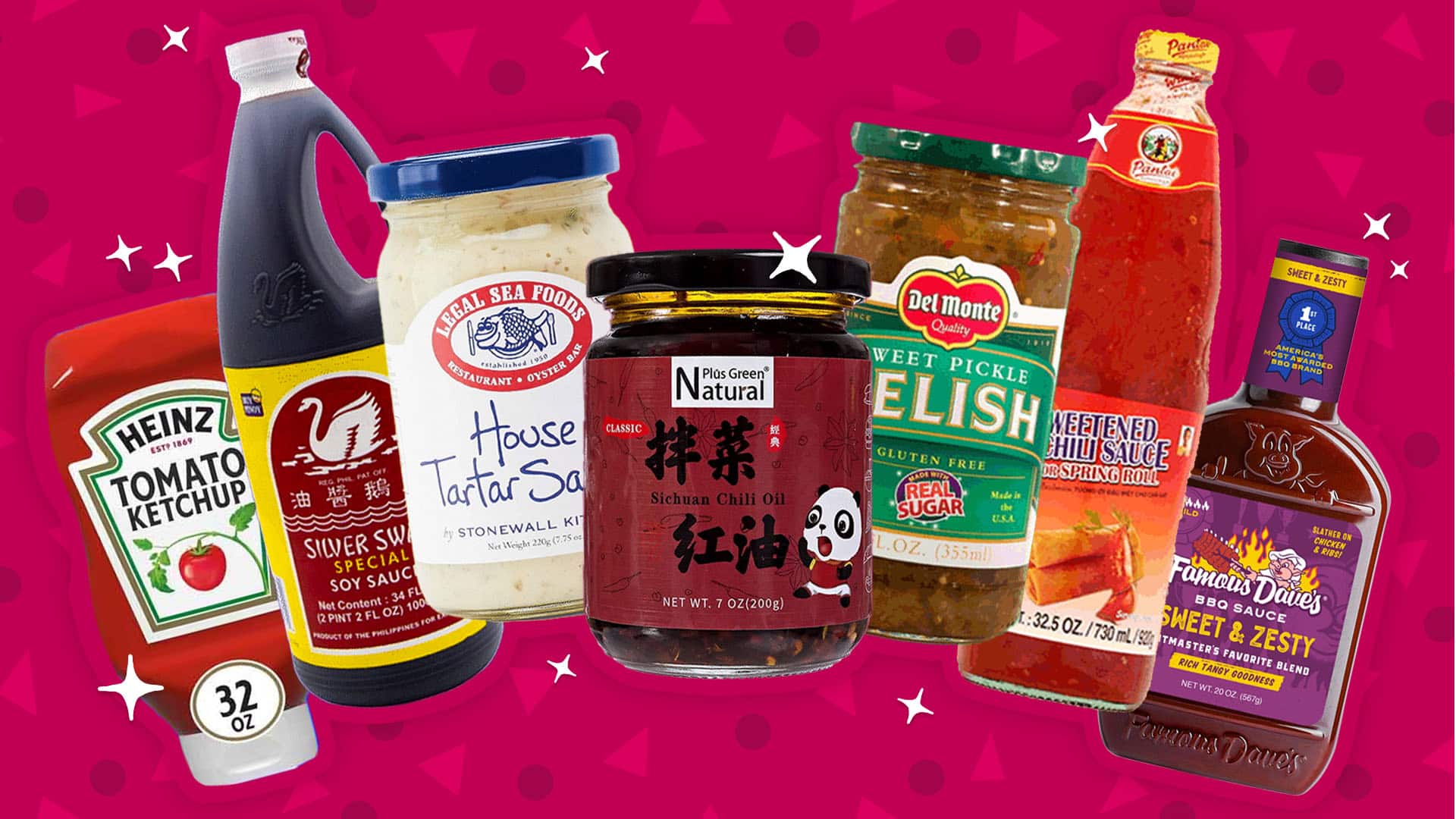To make our favourite foods the tastiest that they can be, condiments are key. Bangers and mash is made the dish it is with the addition of a splodge of brown sauce, and no bacon sandwich is complete without tomato ketchup. Here is a list of our favourites:Salt and Vinegar – The pairing of these kings of condiments was genius, the saltiness mixed with the acid of vinegar makes their inclusion on fried potatoes essential; and place them firmly in the centre of the dinner table at all times.
Tomato sauce – Tomato Sauce or ketchup as North America calls it, is the condiment of choice the world over. There are varying levels of quality of ketchup, but it is widely agreed that Heinz is perceived as the best. Thick and tomato-y it is perfect on burgers, with fries, fish fingers, next to steak, in fact ketchup compliments almost any savoury food.
 Brown Sauce – The more mature choice to ketchup, brown sauce is a bit fruitier and a bit spicier. Perfect with meats, cheeses and even on plain crisps, the HP variety, bearing Parliament on its label, is famous all over the world.
Brown Sauce – The more mature choice to ketchup, brown sauce is a bit fruitier and a bit spicier. Perfect with meats, cheeses and even on plain crisps, the HP variety, bearing Parliament on its label, is famous all over the world.
Salad Cream – Known as the poor man s mayonnaise, salad cream has experienced something of a resurgence in the last few years. Used as mayonnaise is, with tuna or prawns for sandwiches or on the side of a salad plate, it is proving to have developed quite a cult following.
Olive Oil – Once considered posh and exotic, olive oil is commonplace in the common kitchen. It can be used for dipping bread, and makes a wonderful salad dressing. It is also an essential base for homemade mayonnaise and sauces.
Mint Sauce – Serve mint sauce with lamb for the very best results to tantalise your taste buds. Mint compliments the meat perfectly; and home made mint sauce can be easily made by grinding fresh mint in a bowl and adding balsamic vinegar.
Mustard – Perfect on hotdogs or with steak, mustard comes in many guises. French or Dijon mustard is mild and creamy; some mustard s have whole grains of the plant in them; and English mustard has that hot bite that if not properly monitored can go up your nose and burn your eyes.

Horseradish Sauce – This can be bought, or if you are lucky enough to hunt out wild horseradish root made at home. It is the traditional accompaniment to roast beef, matched by none.
Mayonnaise – Mayonnaise can be used on salads and to make sandwich fillings such as tuna mayo, prawn mayo and even coronation chicken. This creamy delight made from eggs should be used sparingly because of its fat content, but is particularly tasty on salads.
Truffle Oil – Truffle oil is an unusual synthetic oil that mimics the scent and taste of the world s most expensive fungi. Add this to risotto s and pasta dishes to evoke the taste of decadent Italy in your cooking.
Wasabi – A green Japanese mustard-tasting condiment, served with Sushi. This is peppery hot and should be used sparingly and with caution.
Food Safety Tips for Picnics
Picnics are an essential part of summer fun. It is always relaxing to get outdoors and enjoy your friends and family while indulging in each other’s cooking. Picnics are a great way to capitalize on fresh air and sunshine which, depending where you live, are not always available. If you are planning a picnic, here are a few things you need to know beforehand about food safety.
How Long Is Food Safe?
Every type of food has different rules when it comes to storage and maintenance. Some foods are safe to be eaten even when sitting out for hours at a time, and even overnight. Other foods are touchy, need to be kept at a certain temperature, and risk going bad quickly when stored otherwise. Bacteria grows the best between 40 and 140 degrees F, and if you leave food out longer than two hours you run the risk of ending up with a bad case of food poisoning. If the temperature outside is hotter than 90 degrees, food should not be out longer than one hour. Another important thing to remember is that food that has been sitting out should never be put back in the fridge or used again, but instead should be thrown out. When deciding how long food can sit out, be sure to include the driving time it took to get to the function.
How to Prolong Food’s Shelf Life and Other Food Safety Tips
Plan ahead on how to store any kind of food you are taking to a picnic. Even if the food is normally fine in room temperature, picnics tend to expose it to more heat than normal, along with sunshine and various bugs and other contaminants. Always take containers that have lids to be used when no one is using it, as this will help with proper heat control and assist in keeping germs out. When a food requires refrigeration, be sure to keep it either in a thermos that will keep it cool, or on ice. Be sure to take proper utensils to avoid a situation where individuals begin using their own cutlery to remove the food from the dish.
Foods to Pick
Most fruits and vegetables don’t require refrigeration. Along with the fact that they are healthy and contain numerous vitamins and minerals, this makes them a great choice for picnics. Bread may dry out a little, but tends to be fine with varying temperatures. Hard cheese lasts fairly well, as long as the sun isn’t shining directly on it.
Foods to Ditch
Some of the worst foods to take on a picnic include anything with meat, because of the dangers of it going bad. Although potato salad seems to make it to almost every picnic, it is a poor choice – not only because of the eggs, but the mayonnaise can go bad very quickly as well. Keep an eye open for any foods that contain serious health threats due to compromised storage temperature, or ingredients that do not hold up well in extreme conditions. Picnics can be great fun, because what is better than fresh air, sunshine, exercise and some great food to indulge in with friends? Food safety, however, must always be kept at the forefront. With a little knowledge and a bit of pre-planning, you can make your next picnic both delicious and incident-free. Food Safety Tips for Barbecues Barbecues are a great time to get together with friends and family. The noise of loved ones, fresh air and the wonderful aroma of barbecued foods is a recipe for a great time. But with this fun comes the responsibility of knowing all of the food safety tips for barbecues.
Proper Refrigeration
No one wants food poisoning, and because of this you need to make sure to keep your foods properly refrigerated before and after they are barbecued. Foods, and especially meat of any kind, needs to be kept in the refrigerator as long as possible before being cooked. Don’t let the meat marinate on the shelf, as bacteria can begin to grow under these circumstances. Play it safe and move the items in your fridge around the night before so that you have ample room to store all your various foods there on the day of the barbecue.
Keep an Eye on the Temperature
Always know the temperature on the day you are having your barbecue. Whether your meat is being brought back into the house or sitting outside, know what conditions you are working with temperature-wise. If it is a hot day, be sure to keep the meat in the shade or indoors. Don’t ever allow food to sit in direct sunlight as it can spoil very quickly. If it is hot both indoors and out, put the most sensitive items in the fridge or in a slow cooker, with a sign directing guests where to fill their plates.
Make Only as Much as Needed
When you are cooking items such as meat, make only as much as needed, plus a little more. Although everyone loves leftover barbecue, it is much more important to keep food safety rules as first priority, and to get rid of any leftovers. Because of this, make smaller batches of food and simply quit once everyone seems to have gotten their fill. If this means that individuals have to wait for second helpings, this is preferable to food spoiling and harming your guests. Besides, they will surely be able to find someone to chat with while waiting for their steak or burger to cook.
What Meat Can Be Eaten Pink?
There are rules of barbecue safety that must be followed if you want to have an incident-free event. Pork and chicken must always be cooked thoroughly. When it comes to beef, there is a rule of thumb that should be followed. Any meat that has ever been exposed must be cooked. That means that when it comes to steak, you can leave the inside pink if you wish, as long as the outer edges are well-cooked. For ground beef, since all of it has been ground up and exposed at some point, it must be cooked through.
Don’t Cross-Contaminate
Vegetables will not need to be cooked as long as meat. For this reason, leave your vegetable skewers and other non-meat items separate from the meat. Add the vegetables to the grill near the end when the meat is almost cooked, instead of the beginning when raw juices are on the grill. Barbecues are a good time to showcase your cooking skills. Keep it safe and learn how to make your time enjoyable and free of food poisoning episodes. Follow these rules and you will have a great time as you barbecue, leaving your food safety worries aside.
Discover more from Personal Blog of Richard Tong
Subscribe to get the latest posts sent to your email.




